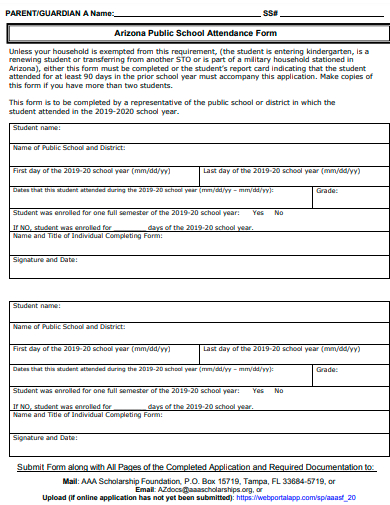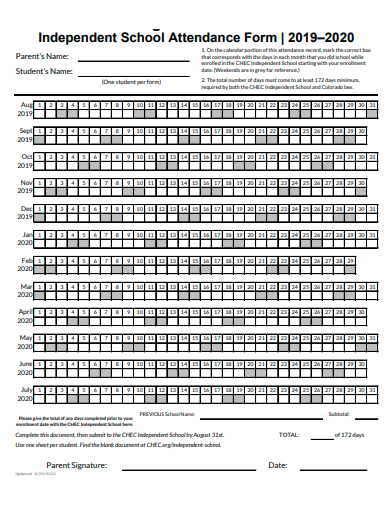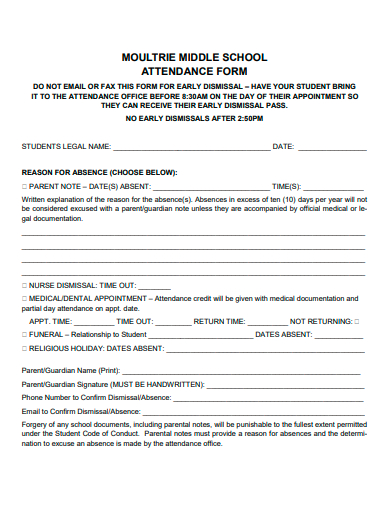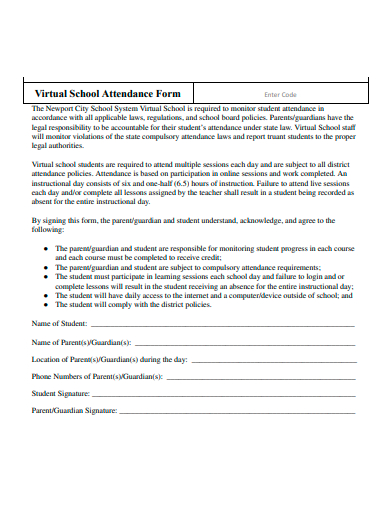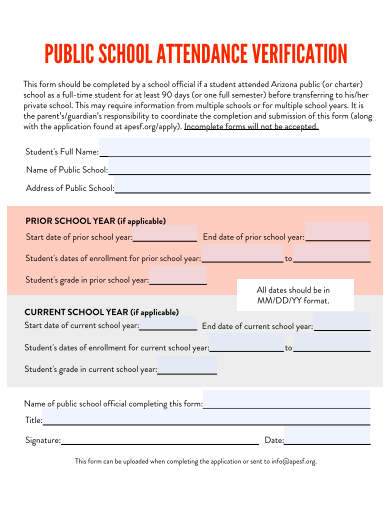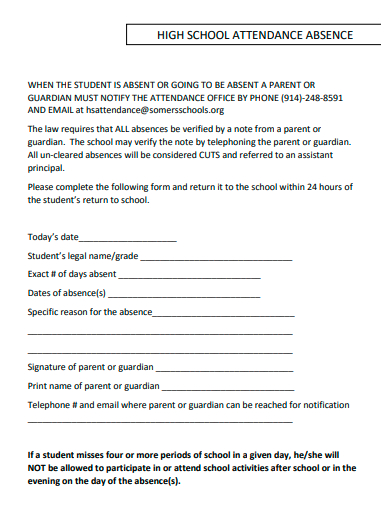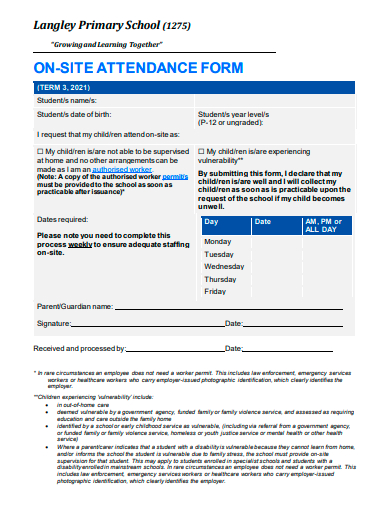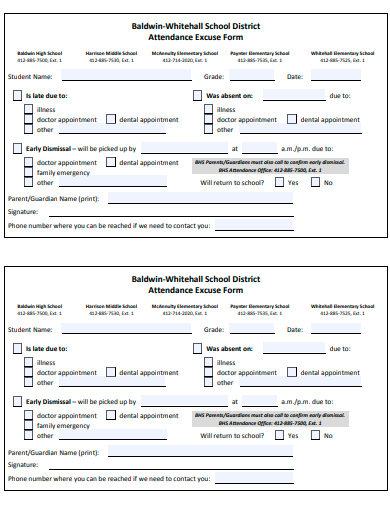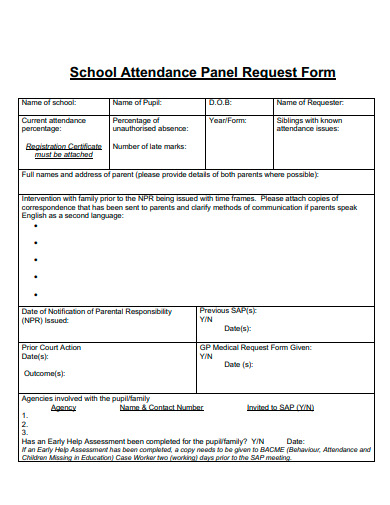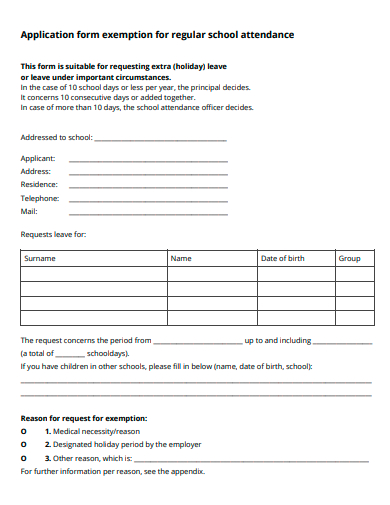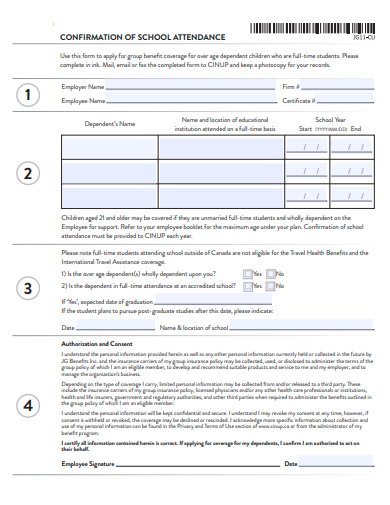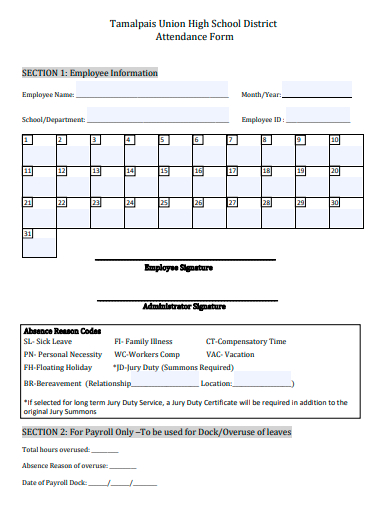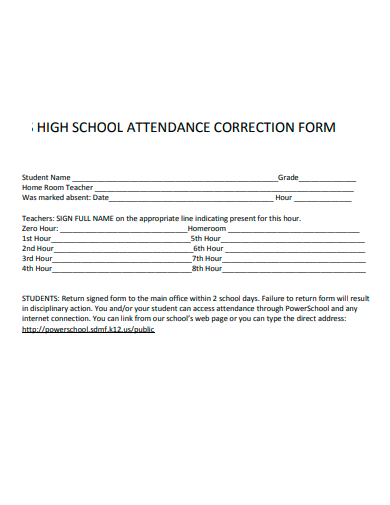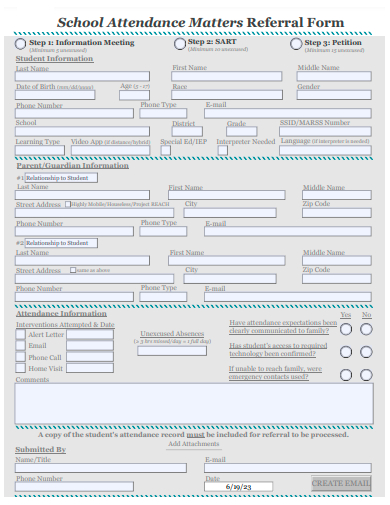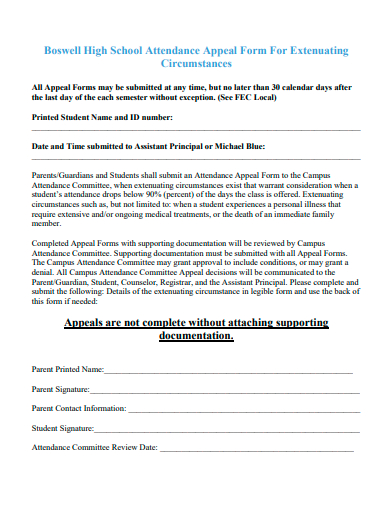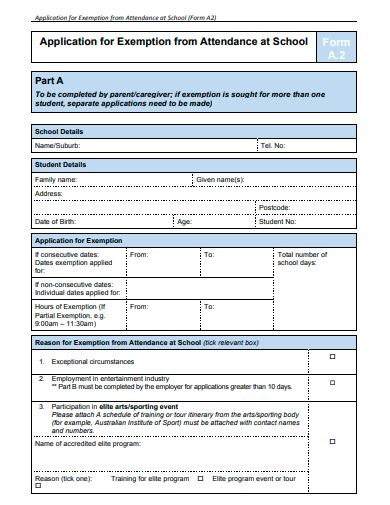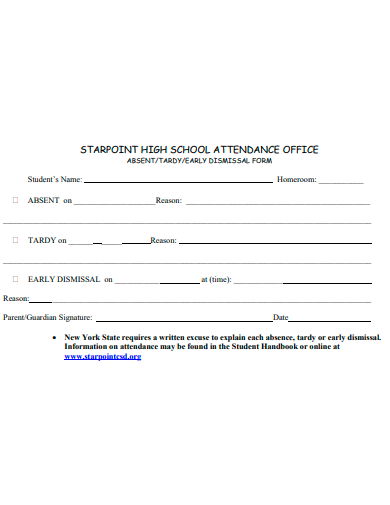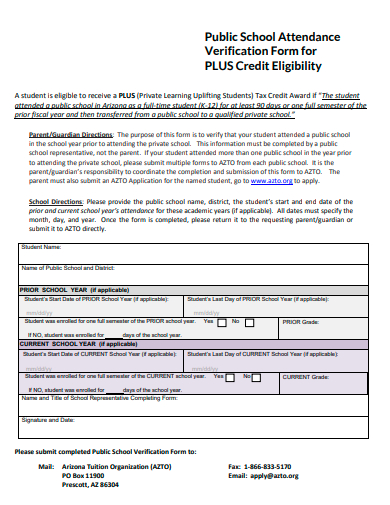In the ever-evolving landscape of academic management, the right tools are pivotal. Our Sample School Attendance Form Template emerges as a beacon of efficiency and clarity. Designed as a cornerstone of the modern Education Form collection, this template empowers educators to accurately monitor student attendance with ease. For teachers desiring detailed logs or administrators striving for streamlined operations, our form becomes an invaluable ally. Step into a world where the art of attendance tracking meets the finesse of our meticulously crafted Education Form.
20+ School Attendance Form Samples
1. Public School Attendance Form Template
2. Independent School Attendance Form Template
3. Middle School Attendance Form Template
4. Virtual School Attendance Form Template
5. Public School Attendance Verification Form Template
What is a school attendance form?
A school attendance form is an indispensable tool within the educational framework, serving as a record of a student’s presence, punctuality, and participation in the academic environment. Delving into its significance and functionalities reveals the multi-faceted roles this seemingly straightforward document embodies.
Definition:
At its essence, a school attendance form is a document or electronic record that captures the presence or absence of students over a defined span. These durations can range from daily to weekly or even monthly intervals. Typically, the form encompasses fields for student names, dates, and markers indicating whether a student was present, late, or absent.
Importance:
Accountability: Attendance forms anchor students to a sense of responsibility for their punctuality and presence. A direct correlation often exists between regular attendance and enhanced academic performance. Keeping track of this attendance helps in pinpointing students who might be drifting due to recurrent absences.
Legal Implications: Many regions have legal mandates dictating school attendance up to a certain age. Persistent and unexplained absences could lead to legal ramifications for parents or guardians. In these instances, the form acts as an authoritative record that can be consulted.
Financial Implications: For certain school districts, their funding mechanism hinges on the average daily attendance figures. Maintaining precise attendance logs ensures that educational institutions garner the right amount of financial support.
Features:
Student Details: A standard starting point for these forms includes basic data like the student’s name, grade, and roll number.
Date and Day: Each entry typically has a segment for noting the date and, at times, the day of the week.
Attendance Markings: Designated columns or spaces are reserved for annotating attendance statuses, such as ‘Present’, ‘Absent’, ‘Late’, or ‘Excused’.
Remarks Section: This segment allows for annotations regarding reasons for absences or other relevant insights.
Digital Evolution:
The march of technology has ushered many educational institutions from the realm of traditional paper-led attendance sheets to sophisticated digital platforms. These digital solutions often bring to the table added functionalities like automated absence notifications to parents, seamless integration with overarching school management systems, and robust data analytics to discern attendance patterns.
Broader Role in Student Welfare:
Attendance forms, beyond their primary function of record-keeping, can be instrumental in unearthing potential welfare concerns. Regular absences might shed light on challenges at home, health complications, or instances of bullying in school. Recognizing these patterns early on equips school authorities and counselors with the means to step in and extend the requisite support.
While at first glance, a school attendance form may appear to be a mere administrative requirement, its reach is far more profound. It’s not solely about marking attendances; it’s a lens through which educators can gauge student behavior, ensure an enriched educational experience, and pinpoint potential challenges that could impede a student’s academic voyage. Whether in its traditional paper form or its digital avatar, the attendance form remains a cornerstone in the vast edifice of education.
6. School Attendance and Progress Form Template
7. High School Attendance Absence Form Template
8. High School District Attendance Change Form Template
9. Primary School On-Site Attendance Form Template
10. School Attendance Excuse Form Template
11. School Attendance Panel Request Form Template
How to Fill Out School Attendance Form?
Filling out a school attendance form is a routine yet crucial task for educators. Ensuring accuracy and consistency is vital, as these records can play a significant role in student welfare, academic progress, and even funding or legal matters for the school. Here’s a step-by-step guide on how to meticulously fill out a school attendance form:
Understanding the Layout:
Before marking any attendance, familiarize yourself with the form’s structure. Most attendance forms will have columns for student names, dates, and attendance status, such as ‘Present’, ‘Absent’, ‘Late’, or ‘Excused’. There might also be a section for remarks or additional notes.
Start with the Basics:
Date: Always begin by ensuring that the date at the top of the form is correct. This ensures you’re recording attendance for the right day.
Class/Grade: If the form is not pre-filled, indicate the specific class or grade for which you are marking attendance.
Marking Attendance:
- Present Students: As you call out each student’s name, wait for a response. If the student responds or if you see the student in class, mark them as ‘Present’ by ticking the appropriate column or box next to their name.
- Absent Students: If a student doesn’t respond after calling their name and isn’t visible in class, mark them as ‘Absent’.
- Late Arrivals: Students who come in after you’ve taken attendance, but during the same period, can be marked as ‘Late’. This helps differentiate between students who missed the entire class and those who attended a portion.
- Excused Absences: Some students might have valid reasons for not attending, like medical conditions, family emergencies, or school-sanctioned activities. In such cases, mark them as ‘Excused’ if your form has this option.
Utilizing the Remarks Section: - Reason for Absence: If you’re aware of why a student is absent (maybe they’ve provided a note or informed in advance), note it down in the remarks section.
- Behavioral Notes: The remarks section can also be used to jot down any notable behaviors, like students who were particularly participative or those who seemed distracted.
- Other Observations: Any other pertinent observations, like if a student left early due to illness or if there was a substitute teacher that day, can also be recorded here.
Double-Check:
Once you’ve marked attendance for all students, take a moment to review the form. Ensure there are no discrepancies or missed names. This is especially vital for larger classes where it’s easy to overlook a student.
Digital Attendance Forms:
If your school uses digital platforms for attendance, the process might differ slightly. Often, these platforms allow for automatic date settings, dropdown menus for attendance status, and easy remark entries. Ensure you’re familiar with the software and always save or submit after marking attendance.
Storage and Confidentiality:
After filling out the form, store it in a designated place, ensuring the records are easily accessible yet confidential. If you’re using a digital platform, ensure you’re logged out to maintain privacy.
Filling out a school attendance form is more than a mere administrative task; it’s a responsibility to ensure each student’s academic journey is correctly documented. Whether done manually or digitally, accuracy and attention to detail are paramount to ensure these records serve their many essential purposes.
12. Regular School Attendance Application Form Template
13. Kindergarten School Attendance Form Template
14. School Attendance Confirmation Form Template
15. High School District Attendance Form Template
16. High School Attendance Correction Form Template
17. School Attendance Matters Referral Form Template
18. High School Attendance Appeal Form Template
19. Printable School Attendance Form Template
20. School Attendance Office Form Template
21. School Attendance Form in PDF
Who Can Use a Student Attendance Form?
A student attendance form is a fundamental document within the educational system, and its importance extends beyond just noting down who’s in class and who’s not. This document serves multiple stakeholders, each having distinct reasons for accessing and utilizing the information it provides. Let’s delve into the various individuals and entities who can and do use a student attendance form:
Classroom Teachers:
The most immediate users of attendance forms are classroom teachers. Daily attendance helps them keep track of which students are consistently present, allowing them to monitor student engagement, participation, and progress. If a student is frequently absent, a teacher can address the issue promptly, ensuring the student doesn’t fall behind.
Substitute Teachers:
When the regular classroom teacher is absent, substitute teachers rely heavily on attendance forms. This not only helps them know the students by name but also assists in maintaining continuity in classroom management and instruction.
School Administrators:
Principals, vice-principals, and other administrative staff frequently access attendance records to monitor overall school attendance rates, address truancy issues, and ensure compliance with educational mandates. Regular reports might be generated from these forms to gauge overall school performance and determine areas needing intervention.
School Counselors:
Attendance can be a reflection of a student’s emotional, social, or even physical well-being. Consistent absences might signal problems at home, health issues, or challenges like bullying. Counselors often review attendance forms to identify students who might need additional support or intervention.
Parents and Guardians:
While parents don’t typically fill out attendance forms, they might review them during parent-teacher meetings or if provided with copies by the school. This allows them to track their child’s attendance and address any issues that might be causing frequent absences.
Extracurricular Activity Coordinators:
For students involved in extracurricular activities, regular school attendance might be a prerequisite for participation. Coaches, club leaders, and other coordinators can refer to attendance forms to ensure members or participants meet the requirements.
School Health Personnel:
In situations where a student’s absence is health-related, school nurses or health personnel might access attendance records. This aids them in tracking potential outbreaks, understanding recurrent health issues in students, or following up on extended absences due to illness.
Legal and Compliance Authorities:
In regions where school attendance is legally mandated up to a certain age, authorities might review attendance forms to ensure compliance. Schools might be required to submit attendance records as proof of adherence to these regulations.
Research and Policy Makers:
On a broader scale, attendance records can inform educational research. Researchers and policymakers might analyze aggregated attendance data to understand trends, inform educational strategies, and shape policies.
The humble student attendance form, while straightforward in its design, serves a vast array of users, each tapping into its records for varied and vital reasons. It’s a testament to the interwoven and comprehensive nature of education, where every piece of data can provide valuable insights and inform decisions that impact the future of students.
Related Posts
Sample Sworn Affidavit Forms
Vehicle Inspection Forms Samples & Templates
Sample Employee Advance Forms
Sample Child Travel Consent Forms
Sample Testimonial Request Forms
Sample Employee Details Forms
Sample Divorce Forms
Sample Attestation Forms
Employee Performance Appraisal Form Templates
FREE 9+ Sample Presentation Evaluation Forms in MS Word
FREE 10+ School Admission Form Samples & Templates in MS Word | PDF
FREE 30+ Patient Consent Form Samples in PDF | MS Word
FREE 10+ Sample Sign Off Form Templates in PDF | MS Word
FREE 11+ Sample Medical Consultation Forms in PDF | MS Word
FREE 8+ Sample Donation Forms in PDF | MS Word

